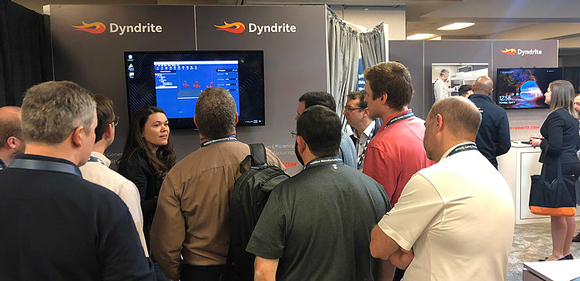Dyndrite introduces accelerated geometry kernel and Additive Toolkit
April 2, 2019

Dr Laura Laruti, Dyndrite’s Chief Scientist, in discussions at AMUG (Courtesy Dyndrite)
Dyndrite Corporation, a software developer based in Seattle, USA, is seeking to revolutionise the next generation of software used in the Additive Manufacturing industry. Following over three years of development, the company launched its Dyndrite Accelerated Geometry Kernel, along with the Dyndrite Additive Toolkit, during the opening day of the Additive Manufacturing Users Group (AMUG) 2019 Conference in Chicago, March 31 – April 4.
Reported to be the world’s first fully GPU-native geometry engine, the Dyndrite Kernel is capable of representing all current geometry types and handling additive specific computations such as lattice, support, and slice generation. It also provides both C++ and English-readable Python APIs, making application development more accessible to users, and the ability to quickly develop sophisticated next-generation applications and interactive workflows possible.
“The Dyndrite Accelerated Geometry Kernel promises to do for 3D printing what Adobe and PostScript did for 2D printing in the 1980’s,” stated Shawn Hopwood, Dyndrite’s Chief Marketing Officer and Head of Developer and OEM Relations. “Laser printing technology powered by PostScript set off a revolution that forever changed how people communicate. In the new revolution, 3D printers powered by Dyndrite have the potential to change every aspect of the things we make, where we go, and how we live.”
The Dyndrite Additive Toolkit is the first customer-facing application built on the new Dyndrite kernel. It is designed to improve the productivity of Additive Manufacturing technicians. It streamlines the CAD-to-Print process by directly importing CAD design files, maintaining the original spline data, and using that data to drive the AM process. Working directly with CAD data is said to provide numerous advantages over STL files. The STL file is a 30-year-old format that Dyndrite claims to be a major bottleneck in additive workflows., being difficult to modify safely, and typically require time-consuming manual repair work prior to being used. Additionally, their fixed reliance on triangles limits the precision of the workflow model and the output quality.
Working directly with CAD spline data, and the richer information it provides, enables Dyndrite users to eliminate model prepping steps and determine desired output quality. The underlying GPU-based kernel means other additive workflow processes which used to take hours of processing time – such as creating lattices or lightweighting, support generation, slicing, hatching, and toolpath generation – now occur on the fly.
“Dyndrite is delivering on the promise of modern design and manufacturing,” stated, Harshil Goel, Dyndrite’s co-founder and CEO. “We are excited to play an important role in fostering the evolution of design and manufacturing software.”
Developer Program and Developer Council
During AMUG, Dyndrite also has launched its Developer Program and announced the inaugural members of its Developer Council.
The Dyndrite Developer Program is reported to provide the tools, resources, and community that application solution providers and OEMS need to create and exchange new additive applications, workflows, and best practices. “The accessibility of the Dyndrite platform opens the door to a wide variety of users and use cases,” added Hopwood. “Our goal is to provide an infrastructure that fosters innovation and information exchange and that helps pioneers bring new solutions, we could never imagine, to market.”
Dyndrite also announced the creation and inaugural members of the Dyndrite Developer Council – a member-based group of industry leaders that will help steer the future development of the Dyndrite platform. Inaugural members include Aconity3D, EOS, HP, NVIDIA, Plural AM and Renishaw.
“For 30 years, CAD/CAM developers have relied on outdated and slow-performing CPU-based geometry kernels,” stated Brian Harrison, Director, Advanced Products, NVIDIA. “We’ve worked with Dyndrite to optimise their native GPU-based geometry kernel so customers can have a modern, GPU-based platform that advances design and manufacturing production for today’s complex use cases.”
“We have been really impressed by Dyndrite in their efforts to develop a ground-breaking, GPU based geometry kernel,” added Stephen Anderson, Additive Manufacturing Business Development Manager at Renishaw, Inc. “We are keen to see such technologies introduced into Additive Manufacturing to further empower users in novel design, where greater power is required to handle complexity effectively. As a leading manufacturer of 3D Powder Bed Fusion Metal printers and QuantAM build preparation software, we look forward to now partnering with Dyndrite and our customers to make game-changing parts.”
















